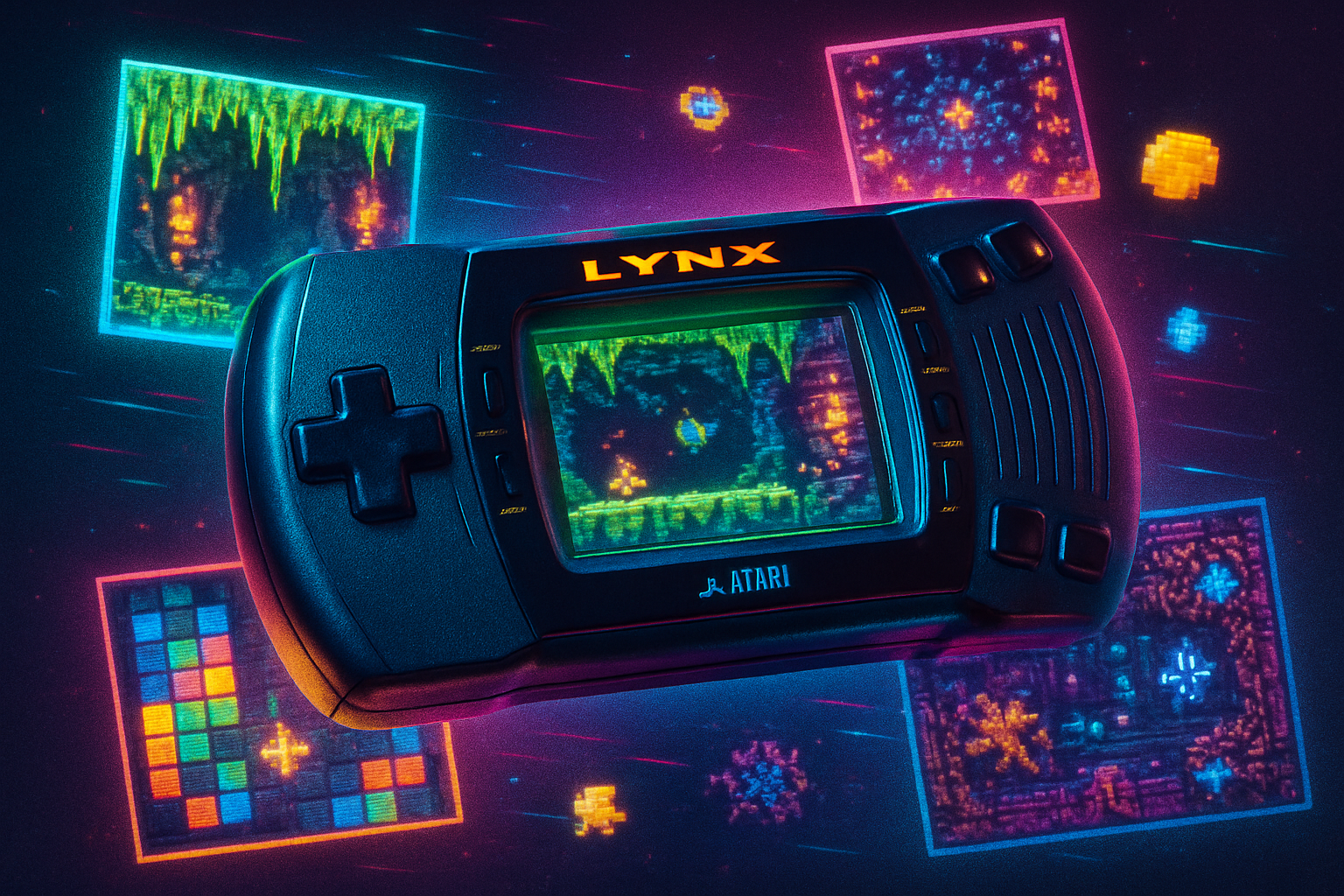· retrogaming · 6 min read
Hidden Gems of the Atari Lynx: Rediscovering Forgotten Classics
A deep dive into lesser-known Atari Lynx titles that deserve renewed attention - highlighting gameplay, what made them special on Atari’s color handheld, and the legacy they left for retro players today.

Why the Lynx still matters
The Atari Lynx may not have won the handheld wars of the early ’90s, but its technical ambitions - a color LCD, sprite scaling, and a hardware palette that could produce arcade-like visuals - let developers experiment in ways other portable platforms couldn’t. That experimentation left us with a small library of games that, while overshadowed at the time, reward modern players with surprising depth, creativity and technical flair.
Below are seven lesser-known Lynx titles that deserve a second look. For each I’ll cover what makes the game special, some gameplay highlights, and the legacy it left behind.
Electrocop (1989)
- What it is - A fast-paced action-title that used the Lynx’s sprite-scaling and multi-plane capabilities to deliver an experience that felt larger than a typical handheld shooter.
- Gameplay highlights - Levels mix run-and-gun segments with tense, enclosed arenas and distinct enemy patterns. The presentation leans into cinematic arrangements and rapid on-screen action - something that visually impressed players used to monochrome systems.
- Legacy - Electrocop is often cited as one of the Lynx’s best demonstrations of raw action on a portable platform. It’s a reminder of what developers could squeeze from the hardware when they designed specifically for it rather than simply porting from bigger machines.
(See Electrocop on Wikipedia for more background: https://en.wikipedia.org/wiki/Electrocop)
Gates of Zendocon (1989)
- What it is - A top-down shooter with exploratory elements and an arcade sensibility. The game is compact but polished, with tight controls and memorable boss encounters.
- Gameplay highlights - Rather than mindless corridor shooting, Gates of Zendocon encourages you to explore multi-screen arenas, locate objectives, and tackle a variety of enemy patterns. Its smooth scrolling and strong audio design make it one of the Lynx’s most enjoyable shooters.
- Legacy - Though not a blockbuster, Zendocon remains a go-to title for fans who want a focused shooter that plays as well as it looks on the handheld.
(More info: MobyGames entry - https://www.mobygames.com/game/lynx/gates-of-zendocon/)
Todd’s Adventures in Slime World (1990)
- What it is - An oddball, cooperative action-exploration game with charismatic visual design and quirky enemy/level mechanics. Slime World blends platforming, resource management and maze-like exploration.
- Gameplay highlights - Slime behaves like a living environmental mechanic - it spreads, changes pace, and creates emergent challenges. The game shines in multiplayer via the Lynx’s ComLynx: up to four players can cooperate, resulting in chaotic and hilarious sessions where teamwork is as important as reflexes.
- Legacy - Slime World is a cult favorite for its originality and for proving the Lynx could host complex, co-op-focused designs. Designers and indie developers who like emergent mechanics often point back to titles like Slime World as early examples of creative risk-taking on handhelds.
(Background: https://en.wikipedia.org/wiki/Todd%27s_Adventures_in_Slime_World)
Chip’s Challenge (1989)
- What it is - A deceptively simple tile-based puzzle game that originally debuted on the Lynx before gaining wider fame on PCs.
- Gameplay highlights - Each level is a compact logic puzzle built around switches, keys, block-pushing, ice floors, and enemies. The design is tight and increasingly inventive across dozens of levels, rewarding patient observation and pattern recognition rather than twitch reflexes.
- Legacy - Chip’s Challenge became a puzzle classic after being ported to other systems, and its level design remains a template for modern puzzle games that want to teach mechanics gradually while ramping up complexity.
(Learn more: https://en.wikipedia.org/wiki/Chip%27s_Challenge)
Xenophobe (1989)
- What it is - A sci-fi shooter adapted from the arcade that emphasizes cooperative play and frantic, room-based combat.
- Gameplay highlights - The Lynx version leaned into local multiplayer through the system’s ComLynx cable, offering a social way to tackle the game’s branching maps and alien-filled rooms. Teamwork and role awareness make the difference between survival and being overrun.
- Legacy - Xenophobe stands as an early example of handheld asymmetric co-op and shows how linking hardware could transform a portable from a solo device into a shared arcade experience.
(Arcade history and ports: https://en.wikipedia.org/wiki/Xenophobe)
Shadow of the Beast (Lynx port)
- What it is - A visually ambitious port of the Amiga classic, made notable on Lynx by its atmospheric visuals and heavy challenge.
- Gameplay highlights - The Lynx’s color capabilities allowed a faithful mood to be retained: layered backgrounds, large sprites and an oppressive soundtrack. Expect tough enemies and a steep learning curve - this one’s about mastering patterns and environments.
- Legacy - Though the series was better-known on home computers, the Lynx port showed the handheld could carry a heavy aesthetic and compete in presentation, even if some fidelity was lost in translation.
(Read about the original and ports: https://en.wikipedia.org/wiki/Shadow_of_the_Beast)
Warbirds (and other overlooked sims)
- What it is - A group of Lynx titles take familiar genres (flight sims, sports, strategic shooters) and condense them into surprisingly deep handheld experiences. Warbirds is one example: a compact dogfighting game that offers more depth than a simple arcade flyer.
- Gameplay highlights - Scenarios often include multiple mission objectives, fuel/weapon management, and tension-filled dogfights where situational awareness matters more than button-mashing.
- Legacy - These titles collectively show how developers adapted large-scale genres for a portable environment. They’re excellent examples of small-team ambition - trying to make a complete experience within the Lynx’s limited screen and control layout.
Why these games still reward play in 2025
- Design-forward - Many Lynx developers designed with constraints in mind, which forced creative mechanics and tight level design rather than relying on flashy ports.
- Local co-op - ComLynx-era multiplayer is a highlight of the library and remains delightful with a handful of friends and a few link cables.
- Technical curiosity - The Lynx did things visually that surprised players at the time. Play these games today and you can appreciate both the raw creativity and the unusual technical solutions developers used.
How to rediscover them today
- Original hardware - Collecting cartridges and a working Lynx is the warmest way to experience these games. Resources such as AtariAge are excellent starting points for collectors and preservationists (
- Emulation - The “Handy” emulator and cores for RetroArch have mature Lynx support if you want to test games quickly on modern hardware. Emulation also makes multiplayer easier to experiment with (search for “Handy emulator” or the RetroArch Lynx core).
- Re-releases and compilations - A few Lynx titles have surfaced in mini-collections or as ROMs bundled with modern retro compilations - check official digital storefronts and retro publishers for legal re-releases.
Final thoughts
The Atari Lynx is less famous than its handheld contemporaries, but its library contains experimental design, delightful co-op, and technical creativity that still rewards exploration. If you’ve only ever played the big-name titles, give the lesser-known entries above a chance - you may find something with a surprising amount of depth, charm, or outright weirdness.
Happy hunting, and if you try one of these, consider sharing how it feels in the modern era - the Lynx’s odd little masterpieces deserve to be talked about again.
Further reading and sources
- Atari Lynx (overview): https://en.wikipedia.org/wiki/Atari_Lynx
- Electrocop: https://en.wikipedia.org/wiki/Electrocop
- Todd’s Adventures in Slime World: https://en.wikipedia.org/wiki/Todd%27s_Adventures_in_Slime_World
- Chip’s Challenge: https://en.wikipedia.org/wiki/Chip%27s_Challenge
- Xenophobe: https://en.wikipedia.org/wiki/Xenophobe
- Gates of Zendocon (MobyGames): https://www.mobygames.com/game/lynx/gates-of-zendocon/
- Shadow of the Beast: https://en.wikipedia.org/wiki/Shadow_of_the_Beast
- AtariAge (community and collecting): https://www.atariage.com/
Note: When trying emulation or ROM downloads, always prioritize legal sources and respect copyright and preservation practices.



